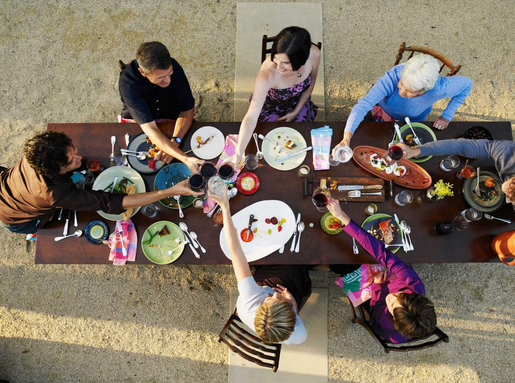How to Create Deeper Connections at Your Next Meal.
Ever-increasing distractions including laptops, iPads, smartphones and now “smart watches” mean being aware and enjoying someone’s company oftentimes falls on the back burner.
We become less present, but busy lives also mean we shy away from cooking or even having a family dinner together. Between our never-ending to-do lists, demanding jobs, children’s busy schedules and perhaps less-than-stellar skills in the kitchen, cooking or even eating together seems to slide down our list of priorities.
That’s unfortunate, considering the numerous benefits of making a meal or even sitting down together to eat.
Amidst today’s go-faster, do-more mentality, I have a radical proposal. We need to reconnect with our kitchen and rediscover its benefits. We also need to reconnect with each other: Sit down and have a meal together.
Humans crave togetherness and connection. Preparing a meal and then enjoying stimulating conversation plies us away from the technological gadgets that disconnect us.
We are bombarded by toxic news and endless gossip. We also live in a toxic food environment, with its slick combination of sugar, salt and fat, pumped into a wide range of packaged food.
As a result, our genes (and our jeans) are overwhelmed. Our taste buds have been assaulted. Our tongues and our brains become victim to craving even more of these toxins. Diabesity and all its repercussions have become the price we pay for this toxic-food onslaught.
Slowing down, enjoying healthy food and creating great conversation are all radical things we can do to fight this toxic food environment.
We also establish lasting habits for our kids. In less than a decade, the rate of pre-diabetes or diabetes in teenagers has risen from nine percent to 23 percent. Almost one in four kids has pre-diabetes or Type 2 diabetes.
Even more shocking, 37 percent of kids at a normal weight have pre-diabetes and one or more cardiovascular risk factors such as high blood pressure, high cholesterol or high blood sugar. Beyond chronic, life-threatening diseases, obese children will tragically earn less, suffer more and die younger.
We can reverse this massive problem for ourselves and for future generations, and the cure lies in our kitchen. Cooking together and having friendly conversation needn’t become time consuming or otherwise burdensome. Start with one night a week.
Cooking real food ultimately becomes a revolutionary act. Sitting down and having stimulating conversation has become a lost art. Our children will grow up without these survival tactics, and their children will face the same fate—not being able to identify common fruits and vegetables, not realizing where food comes from, and feeling isolated rather than connected with others.
We can change that, one meal at a time.
7 Steps to Disconnect and Re-engage
Whether we’re preparing food together or passing it around the family table, a meal becomes a wonderful time to reconnect. Start this new ritual by making the kitchen as warm and inviting as possible.
I’ve found these seven strategies can help families and friends gather around the dinner table for a fun, convivial meal:
- Reclaim our kitchen. Throw away any foods with high fructose corn syrup, hydrogenated fats or sugar or fat as the first or second ingredient on the label. Fill shelves with real, fresh, local foods when possible. Join a community support agriculture (CSA) network to get a cheaper supply of fresh vegetables weekly or attend frequent farmers’ markets.
- Reinstate the family dinner. Read Laurie David’s The Family Dinner. She suggests the following guidelines: Make a set dinnertime, no phones or texting during dinner, everyone eats the same meal, no television, only filtered or tap water, invite friends and family, everyone clean up together.
- Make the kitchen inviting. Create a family playlist that puts everyone in a good mood. Invest in terrific lighting. Change the curtains. Open windows. Put stools by the counter or pillows on the chairs. Make the kitchen a place family or friends want to gather.
- Eat together. No matter how modest the meal, create a special place to sit down together, and set the table with care and respect. Savor the ritual of the table. Mealtime is a time for empathy and generosity, a time to nourish and communicate.
- Learn how to cook and shop. We can make this a family activity, and it does not need to take a ton of time. Keep meals quick and simple.
- Don’t let perfection derail progress. Get everyone involved in the entire process, from prepping ingredients to cooking to sitting down and enjoying the results of our labor. Especially when we’re new to cooking or our skills have gotten rusty, we shouldn’t aim for perfection. Experiment and make it fun!
- Choose inspired conversation. This comes from life coach Lauren Zander, co-founder of The Handel Group and Creator of The Handel Method™. She calls it “Creating a Conversation,” where someone suggests a potential question at the start of the meal. Everyone must agree on the question, and everyone must answer. A few to consider:
- What’s something you can confess that nobody at the table knows about you?
- If your house was on fire and you could save just one of your possessions, what would it be? Why?
- If you could change one thing about yourself, what would it be and why?
What strategy would you add to make the kitchen more convivial and engage your loved ones in a meal with meaningful conversation? Share your thoughts below or on my Facebook page.
~
Relephant Reads:
8 Steps to Stop Your Nighttime Binges.
~
Author: Mark Hyman
Editor: Rachel Nussbaum
Photo: Google free for reuse









Read 0 comments and reply